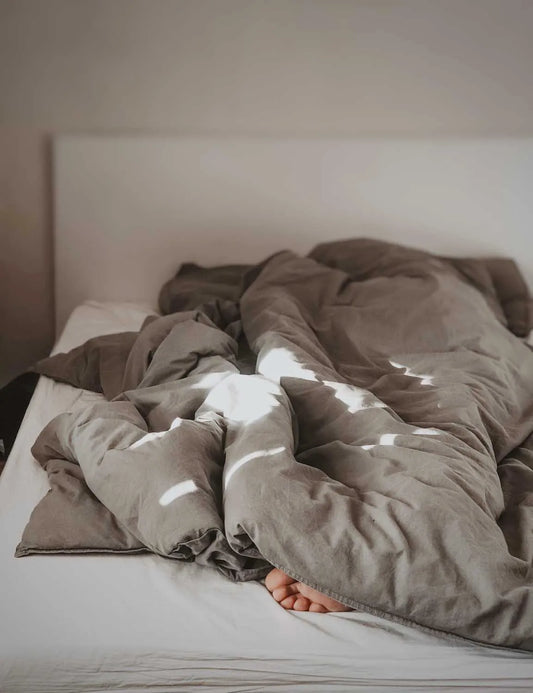Dive into the world of bedroom design and discover how to create your own dreamy bedroom sanctuary. At Remly Sleep, we're dedicated to leveraging research for product development, and The Dream Lab is our way of sharing the knowledge we gain with you.
A good night's sleep is essential for a healthy and productive day. To make sure you get the best possible sleep, it's important to create the ideal sleeping environment in your bedroom. Here are some tips to help you maximize your sleep quality:
Tip 1: Keep it cool
The ideal temperature for sleep is around 65°F/ 18 degree Celsius. A cool room will help you fall asleep faster and stay asleep longer. You can achieve the perfect temperature by:
- Using a fan or air conditioner
- Opening a window for fresh air
- Choosing breathable bed linens
Maintaining a cool bedroom environment is essential for ensuring a restful night's sleep. It's worth noting that a comfortable sleeping temperature may vary from person to person, so it's essential to find what works best for you. If you're still having trouble achieving the perfect temperature, consider investing in a mattress with temperature-regulating properties or a cooling mattress topper.
Tip 2: Make it dark
A dark room signals to your brain that it's time to sleep. To ensure complete darkness:
- Invest in blackout curtains or blinds
- Use a sleep mask
- Turn off or dim electronics with bright lights
Exposure to light during the evening can interfere with your circadian rhythm, making it difficult for you to fall asleep. By minimizing light exposure before bedtime, you can help regulate your sleep-wake cycle and improve your overall sleep quality. For those who spend a lot of time on screens, consider using blue light blocking glasses to reduce the impact of blue light on your sleep.
Tip 3: Control noise
Background noise can disrupt sleep. To create a peaceful and quiet environment:
- Use earplugs
- Invest in a white noise machine
- Soundproof your bedroom with rugs, curtains, or wall hangings
Noise disturbances can be detrimental to the quality of your sleep, especially during lighter sleep stages, such as light sleep. White noise machines or apps can help create a consistent sound environment that can mask disruptive noises and make it easier for you to fall asleep and stay asleep. Learn more about the benefits of white noise for sleep and relaxation here.
Tip 4: Get comfortable
A comfortable mattress and pillow are key for a good night's sleep. To enhance your comfort:
- Investing in high-quality bedding can make a significant difference to the quality of your sleep. The texture, breathability, and durability of your sheets can influence your comfort levels and overall sleep experience. Considering your personal preferences and any specific needs, such as sensitivities or allergies, can guide you in selecting the perfect bedding.
- Choosing the right pillow is essential to maintaining good spinal alignment throughout the night. The ideal pillow depends largely on your preferred sleep position. For instance, side sleepers typically need a firm, high-loft pillow for optimal neck support, while back sleepers may benefit from a medium-firm pillow with a lower loft. Stomach sleepers often fare well with a soft, low-loft pillow. It's worth exploring how different sleep positions impact your sleep and the best ways to support them.
- Regularly rotating and flipping your mattress can also contribute to a more comfortable sleep environment. This practice helps ensure even wear and can prolong the life of your mattress. Depending on the type of mattress you have, you may only be able to rotate it head-to-foot. Always follow the manufacturer's guidelines to keep your mattress in the best condition possible.
Tip 5: Keep it clean
A clean and organized bedroom can help you relax and de-stress before bed. To maintain a tidy space:
- Regularly dust and vacuum
- Keep clutter to a minimum
- Wash your bed linens frequently
Regular cleaning not only contributes to a more pleasant and calming environment, but it can also help reduce allergens such as dust mites and pet dander, which can disrupt sleep. Washing your bed linens at least once a week can help maintain a fresh and healthy sleep environment.
Keeping clutter to a minimum can also have a positive impact on your sleep. A clutter-free space can lead to a clutter-free mind, making it easier to unwind and prepare for sleep. If you're struggling with maintaining an organized space, consider implementing some storage solutions or adopting a minimalist approach to your bedroom decor.
Remember, your bedroom should be a sanctuary dedicated to rest and relaxation. Avoid activities that can lead to a negative association with your bedroom, such as watching TV or using your laptop in bed. These activities can interfere with your ability to fall asleep and diminish the overall quality of your rest.
Did you know? The color blue is known to promote relaxation and calmness, making it a great choice for your bedroom walls. Studies have also shown that sleeping with your pets can have a positive impact on your sleep quality! That is, of course, if your pet doesn't have a nocturnal nature.
Choosing the right color for your bedroom can significantly influence your mood and sleep quality. Different colors can evoke different emotional responses - blue, for instance, has been linked with feelings of calmness and relaxation, making it an excellent choice for a bedroom. Other colors, like green and lavender, can also promote a sense of tranquility.
Interestingly, studies have shown that sleeping with pets can have a positive impact on sleep quality. The presence of a pet can provide comfort and security, which can help promote better sleep. However, it's important to note that this may not be the case for everyone, especially if your furry friend tends to be active during the night. If you're considering welcoming your pet into your bedroom, make sure to establish some boundaries and create a routine that works for both of you.
With these tips in mind, you're ready to create your personalized sleep sanctuary, a place that not only appeals to your senses but also supports your body's natural sleep rhythms. From the temperature and lighting to the bed linens and room decor, every element plays a part in promoting better sleep.
Concluding Thoughts
At the end of the day, the goal is to make your bedroom a place that supports your journey towards better sleep and, ultimately, better health. Remember, sleep is not just a passive state of rest, but an active process that plays a crucial role in our mental, emotional, and physical well-being. Ensuring that you have a sleep-friendly environment can significantly enhance the quality of your sleep.
Applying these tips might not change your sleep overnight, but consistently implementing these strategies can make a substantial difference in the long run. And remember, every individual is unique, so what works best for you might be different from what works for others. Feel free to experiment, adjust, and modify these tips to suit your personal needs and preferences.
Remember, a good night's sleep is within your reach. With some thoughtful adjustments to your bedroom and sleep habits, you can make your dream of restful, restorative sleep a reality. Here's to sweet dreams and waking up feeling refreshed and ready to take on the day!
Thank you for exploring with us at The Dream Lab. Remly Sleep is on a mission to make you sleep better by sharing the latest sleep research and incorporating this knowledge into our innovative products. We're excited to journey together and discover more insights on sleep and well-being.




